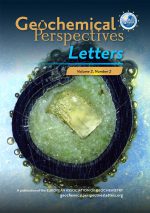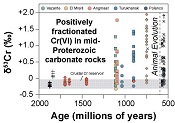 | Oxygenation of the mid-Proterozoic atmosphere: clues from chromium isotopes in carbonates Abstract: Chromium (Cr) isotopes in marine sedimentary rocks can be used as a sensitive proxy for ancient atmospheric oxygen because Cr-isotope fractionation during terrestrial weathering only occurs when pO2 exceeds a threshold value. This is a useful system when applied to rocks of mid-Proterozoic age, where fundamental questions persist about atmospheric pO2 and its relationship to biological innovation. Whereas previous studies have focused on temporally limited iron-rich sedimentary rocks, we present new Cr-isotope data from a suite of mid-Proterozoic marine carbonate rocks. Application of the Cr-isotope proxy to carbonate rocks has the potential to greatly enhance the temporal resolution of Proterozoic palaeo-redox data. Here we report positive δ53Cr values in four carbonate successions, extending the mid-Proterozoic record of Cr-isotope fractionation – and thus pO2 above threshold values – back to ~1.1 Ga. These data suggest that pO2 sufficient for the origin of animals was transiently in place well before their Neoproterozoic appearance, although uncertainty in the pO2 threshold required for Cr-isotope fractionation precludes definitive biological interpretation. This study provides a proof of concept that the Cr-isotopic composition of carbonate rocks can provide important new constraints on the oxygen content of the ancient atmosphere. |
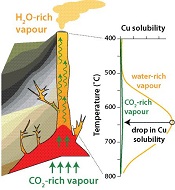 | CO2-fluxing collapses metal mobility in magmatic vapou Abstract: Magmatic systems host many types of ore deposits, including world-class deposits of copper and gold. Magmas are commonly an important source of metals and ore-forming fluids in these systems. In many magmatic-hydrothermal systems, low-density aqueous fluids, or vapours, are significant metal carriers. Such vapours are water-dominated shallowly, but fluxing of CO2-rich vapour exsolved from deeper magma is now recognised as ubiquitous during open-system magma degassing. Here, we show that such CO2-fluxing leads to a sharp drop in element solubility, up to a factor of 10,000 for Cu, and thereby provides a highly efficient, but as yet unrecognised mechanism for metal deposition. |
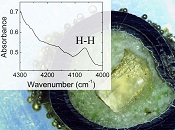 | Molecular hydrogen in mantle minerals Abstract: Current models assume that hydrogen was delivered to Earth already in oxidised form as water or OH groups in minerals; similarly, it is generally believed that hydrogen is stored in the present mantle mostly as OH. Here we show by experiments at 2-7 GPa and 1100-1300 °C that, under reducing conditions, molecular hydrogen (H2) has an appreciable solubility in various upper mantle minerals. This observation suggests that during the accretion of the Earth, nebular H2 could have been delivered to the growing solid planet by direct dissolution in a magma ocean and subsequent incorporation in silicates. Moreover, the presence of dissolved molecular H2 in the minerals of the lower mantle could explain why magmas sourced in this region are rich in hydrogen, despite the fact that lower mantle minerals contain almost no OH groups. |
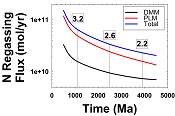 | Release of subducted sedimentary nitrogen throughout Earth’s mantle Abstract: The dynamic process of subduction represents the principal means to introduce chemical heterogeneities into Earth's interior. In the case of nitrogen (N) - atmosphere's most abundant gas - biological-activity converts N2 into ammonium ions (NH4+), which are chemically-bound within seafloor sediments and altered oceanic crust that comprise the subducting slab. Although some subducted N re-emerges via arc-related volcanism (Sano et al., 1998), the majority likely bypasses sub-arc depths (150-200 km) and supplies the deeper mantle (Li et al., 2007; Mitchell et al., 2010; Johnson and Goldblatt, 2015; Bebout et al., 2016). However, the fate of subducted N remains enigmatic: is it incorporated by the shallow convecting mantle - the source of ridge volcanism, or is the deeper mantle - nominally associated with mantle plumes - its ultimate repository? Here, we present N-He-Ne-Ar isotope data for oceanic basalts from the Central Indian Ridge (CIR)-Réunion plume region to address this issue. All on-axis samples with depleted MORB mantle (DMM) affinities (3He/4He = 8 ± 1 RA; Graham, 2002) have low N-isotopes (mean δ15N = -2.1 ‰), whereas those with plume-like 3He/4He display higher values (mean δ15N = 1.3 ‰). We explain these data within the framework of a new mantle reference model to predict a time-integrated net N regassing flux to the mantle of ~3.4 × 1010 mol/yr, with the plume-source mantle representing the preferential destination by a factor of 2-3. The model has implications for the present-day imbalance between N subducted at trenches and N emitted via arc-related volcanism, the N-content of Earth's early atmosphere, as well as relationships between N2 and the noble gases in mantle reservoirs, including 3He/4He-δ15N relationships in plume-derived lavas. |
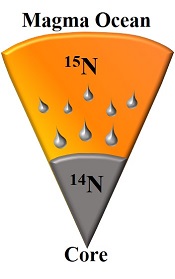 | Nitrogen isotope fractionation during terrestrial core-mantle separation Abstract: The origin and evolution of the terrestrial nitrogen remains largely unresolved. In order to understand the potential influence of core-mantle separation on terrestrial nitrogen evolution, experiments were performed at 1.5 to 7.0 GPa and 1600 to 1800 °C to study nitrogen isotope fractionation between coexisting liquid Fe-rich metal and silicate melt. The results show that the metal/silicate partition coefficient of nitrogen DNmetal/silicate ranges from 1 to 150 and the nitrogen isotope fractionation Δ15Nmetal-silicate is −3.5 ± 1.7 ‰. Calculations show that the bulk Earth is more depleted in δ15N than the present-day mantle, and that the present-day mantle δ15N of −5 ‰ could be derived from an enstatite chondrite composition via terrestrial core-mantle separation, with or without the addition of carbonaceous chondrites. These results strongly support the notion that enstatite chondrites may be a main component from which the Earth formed and a main source of the terrestrial nitrogen. Moreover, in the deep reduced mantle, the Fe-rich metal phase may store most of the nitrogen, and partial melting of the coexisting silicates may generate oceanic island basalts (OIBs) with slightly positive δ15N values. |
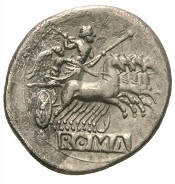 | A glimpse into the Roman finances of the Second Punic War through silver isotopes Abstract: The defeat of Hannibal’s armies at the culmination of the Second Punic War (218 BC–201 BC) was a defining moment in Western world history. One of the underappreciated consequences of the conflict was the Roman monetary reform of 211 BC, which ushered in a monetary system that would sustain Roman power for the next many centuries. This system would encapsulate many of the issues plaguing finances of governments until today, such as inflation, debasement, and the size of monetary mass. Here we approach the issue of financial fluxes using a newly developed powerful tracer, that of silver isotopic compositions, in conjunction with Pb isotopes, both of which we measured in Roman coinage minted before and after the 211 BC monetary reform. The results indicate that pre-reform silver was minted from Spanish metal supplied by Carthage as war penalty after the First Punic War, whereas post-reform silver was isotopically distinct and dominated by plunder, most likely from Syracuse and Capua. The 211 BC monetary reform and the end of debasement, therefore, were aimed at accommodating new sources of silver rather than being the response to financial duress. The drastic weight reduction of silver coins implemented by the Roman mint was not motivated by metal shortage but by the need to block inflation after a major surge of war booty. |
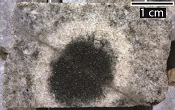 | Compositional symmetry between Earth’s crustal building blocks Abstract: Arc magmatism drives the production of modern continental crust. However, the mode of crustal differentiation in the geologic past, particularly in the Archean, remains controversial. Herein I adopt a compositional approach to interrogate a global, igneous geochemical database (EarthChem Library) and document the evolving compositional history of basalt, andesite, and rhyolite, which represent the three main crustal building blocks. Basalt and andesite yield synced geochemical trends and progressively incompatible element-rich and compatible element-poor compositions that are consistent with extensive partial mantle-melting during the Archean. Post-Archean basaltic to andesitic rocks also tend to be more alkaline in character, which coupled with their high field-strength- and large-ion lithophile-element signature, points to the increased influence of Phanerozoic-style intra-plate magmatism on the global, rock record. Coeval rhyolitic rocks are depleted in these same elements, suggesting that post-Archean felsic magmas track the evolving compositions of their basaltic to andesitic source, which are, in turn, controlled by the partial melting trend. These complementary, or symmetric, geochemical trends between rock types shifted during the Proterozoic and heralded the onset of modern compositional relationships between crustal building blocks. |
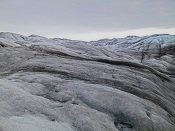 | Experimental evidence that microbial activity lowers the albedo of glaciers Abstract: Darkening of glacier and ice sheet surfaces is an important positive feedback to increasing global temperatures. Deposition of impurities on glaciers is primarily believed to reduce surface albedo, resulting in greater melt and mass loss. However, no study has yet included the effects of biological activity in albedo reduction models. Here, we provide the first experimental evidence that microbial activity can significantly decrease glacier surface albedo. Indeed, the addition of nutrients at ice meltwater concentrations to microbe-impurity mixtures resulted in extensive microbial organic carbon fixation and accumulation in Greenland Ice Sheet surface debris. Accumulated organic carbon, over the period of a melt season, darkened the glacial debris in our experiments from 31.1 % to 15.6 % surface reflectivity (used as an analogue for albedo in our calculations), generating a strongly absorbing surface. Our experiments are the first to quantify the microbially-induced potential melt increase for the Greenland Ice Sheet (up to an average of 17.3±2.5 Gt yr-1 at present and up to ~85 Gt yr-1 by 2100, based on our first order calculations). Mass loss from glaciers will conceivably intensify through enhanced microbial activity, resulting from longer melt seasons and fertilisation from anthropogenic sources. |
<< Previous issueNext issue >>





